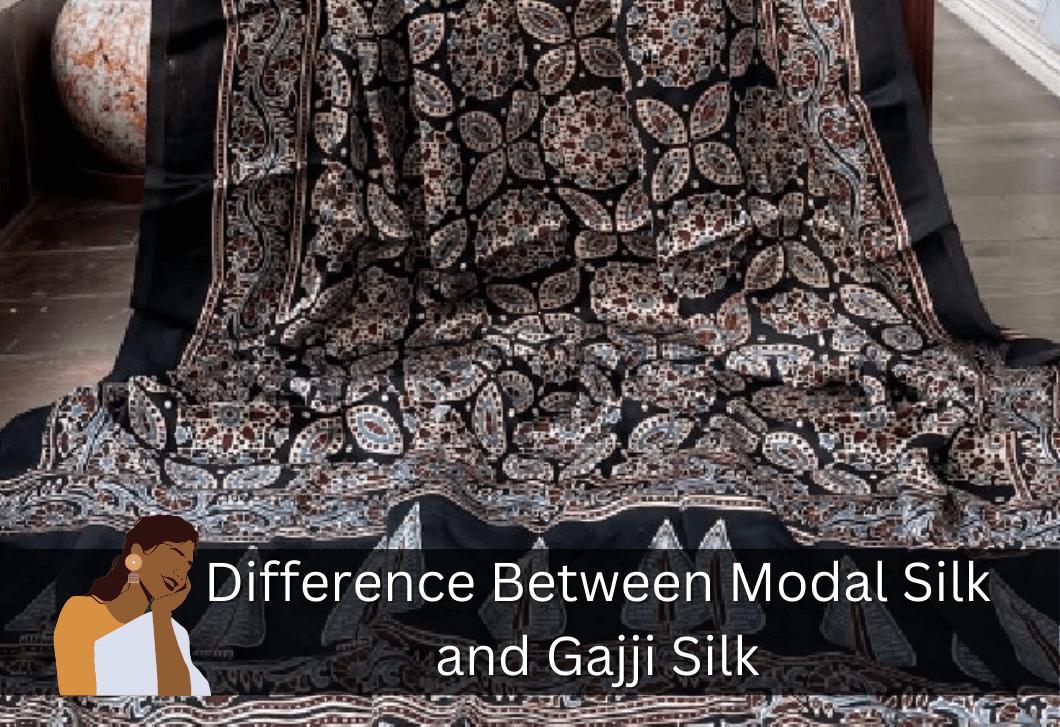Difference Between Modal Silk and Gajji Silk
When it comes to sarees, especially in India, choosing a suitable saree material is the first step for the overall feel and look of the saree.
Silk is one of the most luxurious and desirable saree materials worldwide. Its smooth and lustrous texture and natural sheen make it the first choice for various clothing and home decor items.
However, not all silk fabrics are created equal, with modal and gajji silk being two of the most popular. In this article, we discuss the difference between modal and gajji silk to provide you with a closer look at each of the two.
What is Modal Silk?
Modal silk is a soft, lightweight fabric known for its silky texture and draping qualities. It is a cellulosic fibre derived from beech trees. The cellulose extracted from beech trees is spun by hand into a lovely modal silk fabric.
Modal was first developed in Japan in 1951. Modal silk, combined with cotton, creates an outfit with silk’s smooth texture on the outside and the comfort of the cotton on the inside.
It is a solid fabric due to its high intensity of molecular alignment; it also does not shrink quickly due to its lower surface tension and fibre properties.
Modal Silk Saree and Comfort
A modal silk saree is fuss-free and highly comfortable. This fabric also allows for a wide range of experiments, as evidenced by the weavers’ use of prints and patterns.
It is more expensive as compared to cotton because the process of turning beechwood into cellulose fibre is more labour-intensive. Also, unlike natural fibres like cotton, it requires manual processing.
Modal Silk Ajrakh Sarees
Modal silk – the soft and lightweight fabric – combined with the ajrakh printing method results in a luxurious, comfortable, and visually appealing saree.
With growing awareness and demand for sustainable and eco-friendly fashion, modal silk ajrakh sarees have recently become popular among conscious consumers.
Moreover, the closed-loop production process to create modal silk and natural dyes makes this saree a more sustainable alternative to traditional silk sarees.
What is Gajji Silk?
Gajji silk is a silk fabric made from the cocoons of wild Indian silk moths. After the moth emerges, the silk fibres are harvested from the cocoons, spun by hand, and woven into fabric.
The texture and appearance of Gajji silk are distinct, with a slightly rough and uneven surface. The gajji silk can be typically printed with floral or geometric designs. It has applications in clothing, home decor and other textile products.
The softness, lustre and durability of gajji silk make it highly valued. The fabric has an excellent ability to retain colour and shape over a period of time. Because of their quality, the gajji silk garments have remained relevant for different generations.
Historical Background of Gajji Silk
The history of gajji silk traces back to the 18th century when European traders introduced the fabric to India for the first time. Various garments use gajji silk, including saris and lehengas.
The bright colours and intricate designs set it apart from other fabrics. Its durability makes it ideal for regular clothing. It is still produced traditionally and finds relevancy among Indian women.
What Makes Gajji Silk Unique?
There are a few characteristics that distinguish gajji silk from other types of silk and entice people to go for printed gajji silk fabric:
- The design on gajji silk is applied to the fabric’s surface instead of woven into it, providing the material with a more casual look suitable for daily wear.
- Another differentiating factor is the light weight of gajji silk compared to other silk types. Its lighter weight makes it more comfortable to wear in warm weather.
- Gajji silk usually has a sheen to it due to the way it is processed, making it perfect for creating elegant garments.
Modal Silk vs Gajji Silk
| Modal Silk | Gajji Silk |
|---|---|
| It is derived from beech tree pulp. | It is derived from wild silk cocoons of Antheraea mylitta moths found in India. |
| It is soft and lightweight with a uniform texture and appearance. | It is a rough and uneven surface, and its natural colors range from pale beige to dark brown. |
| It is less intense and durable than gajji silk. | It is stronger and more durable than modal silk. |
| Clothing like dresses, tops, scarves, and home furnishings like bedding and curtains. | It could be used in traditional Indian clothing like saris, kurtis, salwar kameez and home furnishings like cushion covers and curtains. |
| It is machine washable. | It requires a dry clean. |
Conclusion
In conclusion, modal silk can be an excellent choice for people who associate themselves with an eco-friendly fashion. For example, the modal silk ajrakh saree is visually appealing and comfortable.
In case you are someone who associates yourself more with traditional clothing, gajji silk could be the choice for you.
What is the highest quality silk?
The highest quality silk is widely considered to be Mulberry silk, which is produced from the cocoons of the Bombyx mori silkworms. This type of silk is known for its lustre, softness, durability, and hypoallergenic properties, making it a popular choice for luxury clothing, bedding, and accessories.
What are the disadvantages of modal fabric?
Modal fabric is a soft, durable, moisture-wicking textile made from beech tree cellulose fibres. However, it has some disadvantages. Modal fabric is prone to pilling, wrinkles easily, and can shrink if not cared for properly.
The manufacturing process is resource-intensive, and the chemicals used can harm the environment. Additionally, it may not be as breathable as cotton, leading to discomfort in hot weather. Considering these factors is essential when choosing clothing and home textile fabrics.


Leave a Reply